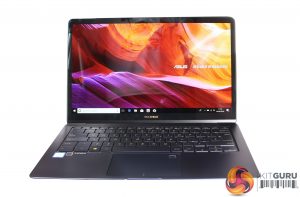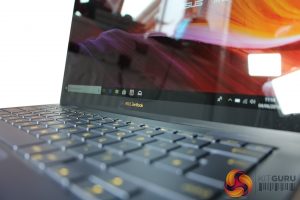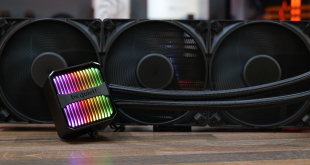Asus has tried to beef up the Zenbook’s entertainment credentials with some high-quality hardware. The screen is a 1080p LED-backlit unit that’s coated with Gorilla Glass 5 – so it should be hard-wearing in all scenarios.
The panel has a claimed 100% sRGB colour gamut coverage level, and Asus also says that it’s got 178° viewing angles and a 1,000:1 contrast ratio.
The screen is a 14in panel despite the Zenbook having the dimensions of a 13in laptop. That means a tiny bezel, which always makes a laptop look more luxurious – especially when compared to the wide bezel on the Razer Blade Stealth. The Zenbook’s 14in panel serves up a density level of 157ppi, which is fine: sharp enough to look crisp without visible pixels, but not small enough that you’ll be reaching for Windows 10’s scaling options.
The screen is paired with a quad-speaker design. That’s unusual for a laptop of this slim size, and we’re excited to find out how the audio kit sounds. Two of the speakers sit on the base of the laptop, towards the front of that underside panel, with two more above the keyboard.
The screen offers immediate, impressive brightness and contrast. The backlight is measured at 287cd/m2, which is ample for bright office lights and outdoor conditions. The black level of 0.22cd/m2 is great, too – a step better than most other notebooks.
Those measurements combine for a contrast ratio of 1,304:1. That’s better than Asus’ claimed 1,000:1 figure, and it means that photo and video content looks incredibly vibrant – no matter what kind of colours you’re observing. The black point means that dark areas look suitably inky, and lighter shares are bright too. The high contrast also means it’s easier to pick out subtly different shades across the range.
In other areas, though, the Zenbook’s screen is more middling. The colour temperature of 7,653K is a little wayward when compared to the 6,500K ideal, which means that colours will appear a little too cool. The Delta E of 2.81 is good, rather than great.
The screen’s backlight varies by a peak of 10% on the right-hand side and 14% on the left-hand side – that’s another average result.
These results may be average, but they’re not going to prove disruptive in everyday use. If you’re watching TV or movies, playing low-end games or browsing the web, the brightness, contrast and reasonable colour results will make everything look top-notch.
The lack of near-perfect colours means the Zenbook isn’t ideal for photo editing or design work, but the slimline specification also precludes that kind of productivity. If you’re interested in that sort of work, you’ll have to spend more cash on a larger and more powerful laptop.
The screen’s strong entertainment credentials, however, are bolstered by the audio kit. The four speakers inside this machine are exceptional: louder and clearer than almost anything you’ll find in a notebook of this size, with no top-end distortion and enough volume for filling a living room. The treble is clear and detailed, too, and there’s even a little bass – although this isn’t exactly overwhelming, because there’s no subwoofer.
Elsewhere, the keyboard is good. The Zenbook’s typing gear uses the same butterfly-style low-profile switch as the latest generation of Apple MacBook. The buttons don’t have much travel, but they’re quiet, comfortable, consistent and fast – all attributes that bode well for productivity. The light keys are conducive to fast typing, too, and the layout is fine.
Lastly, the trackpad offers similar delicacy. The surface is smooth and responsive, and the two in-built buttons are shallow and rapid – so it’s easy to click around the screen.
 KitGuru KitGuru.net – Tech News | Hardware News | Hardware Reviews | IOS | Mobile | Gaming | Graphics Cards
KitGuru KitGuru.net – Tech News | Hardware News | Hardware Reviews | IOS | Mobile | Gaming | Graphics Cards




